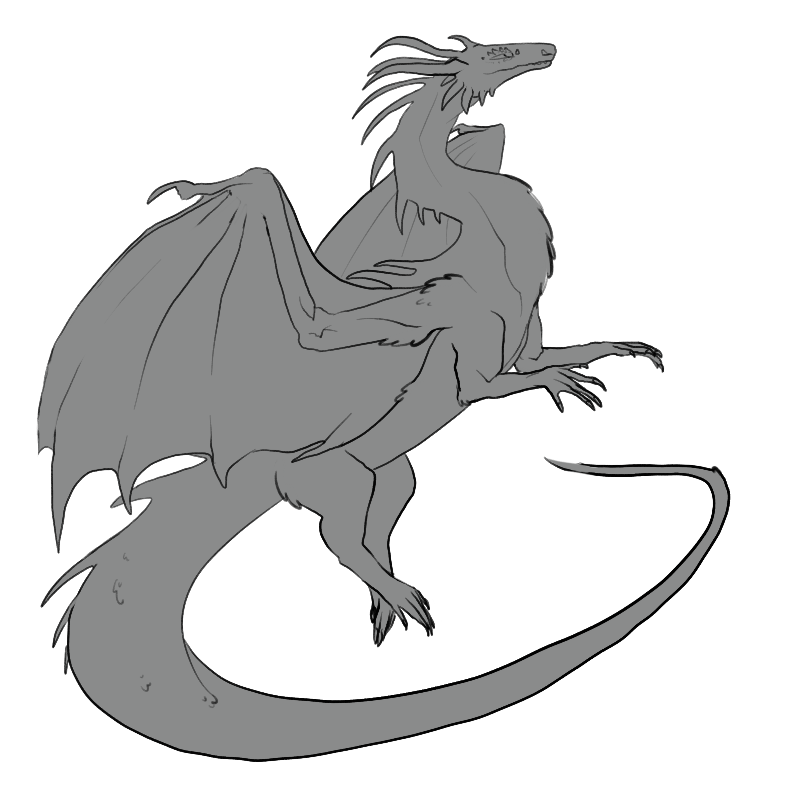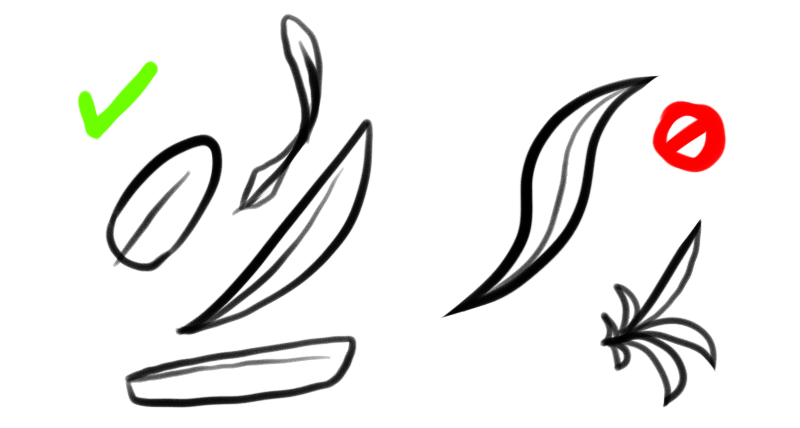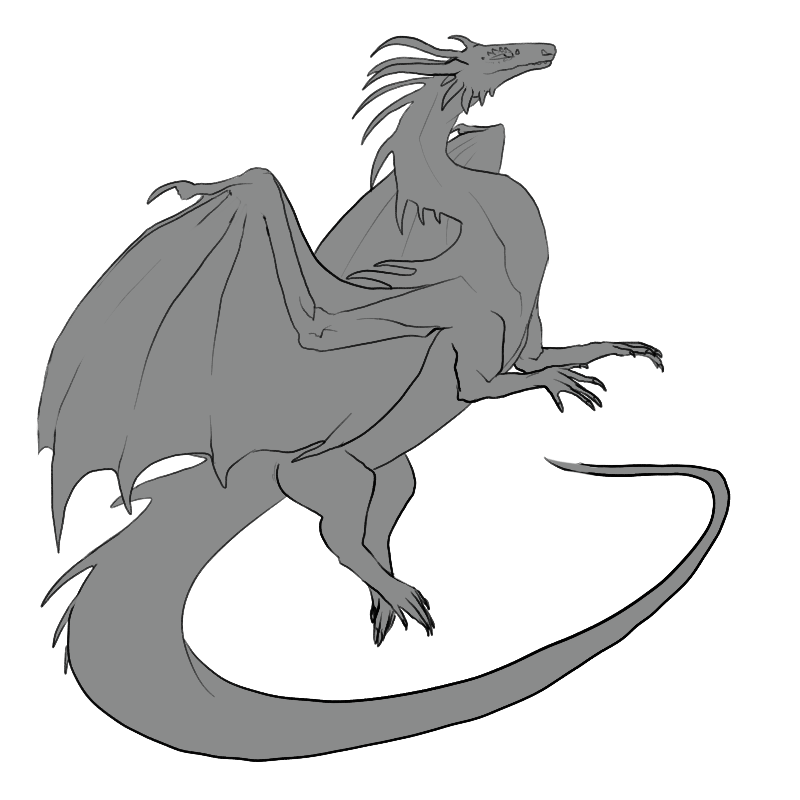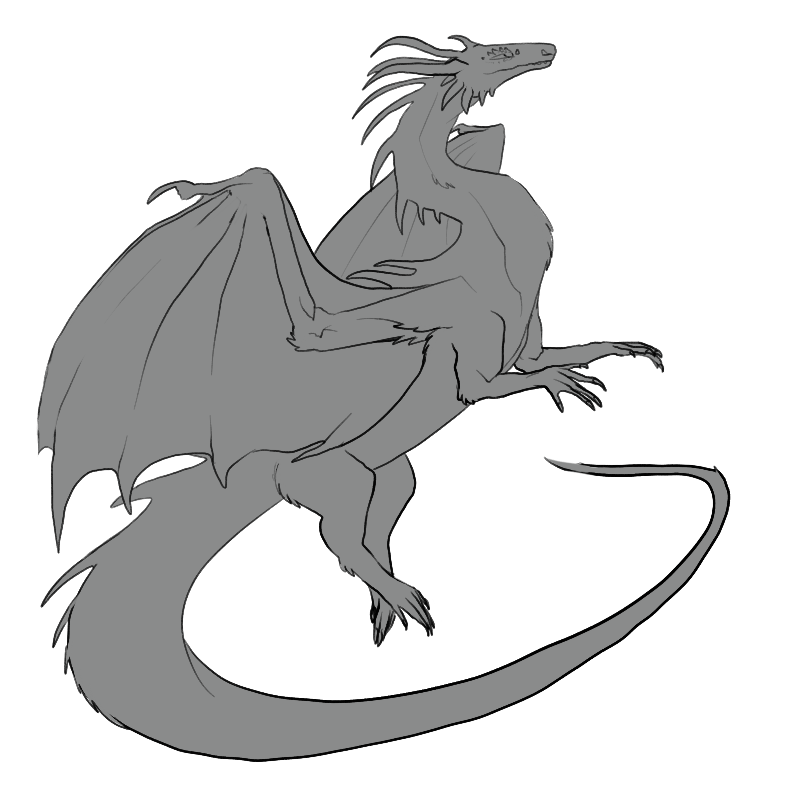Traits
Artificial Scales
Scales may be made of metal, clay, bone, or some other artificial or sculpted substance. They can take any shape, but always serve as a functional covering rather than a decoration. If their natural scales are visible, then there should be an attachment where the artificial scales begin (screws, string, stitching, etc.). If depicted, artificial pieces must cover at least 1/6th of the body. It may blend and connect with other artificial traits, so long as it follows the other rules.

The following list has a few acceptable materials for artificial traits. Their colors must be at 90% opacity or more (see colors for more info on transparency and color). If you do not see something on this list, feel free to ask if it is available!
- Plastic
- Clay
- Metal
- Glass
- Cloth
- Wood
- Bone (note–must be carved/shaped rather than a skeleton on top of the dragon)
All traits must be visibly artificial in order to pass. In example, clay would have a few cracks or flakes, cloth would have something tying it to the rest of the dragon, and metal would have screws on the edges holding them together. You may use up to two materials. Each material must be the same color as all matching materials. In example, if you want to use brown clay as a material, then all other clay must match. Wires, screws, and simple fasteners do not count towards the material limit and may have their own color that matches something else on the dragon. The colors of these extras must still match each other. Fur, feathers, and anything that resembles natural scales will not be accepted even if they are attached with strings, nails, plates, or other artificial things.
Colors
Artificial traits will only have colors natural to their material or colors in the elemental spectrum. For example, a fire dragon cannot be covered in lime green metal. The natural colors of plastics are white and tan. The natural colors of cloth depend on the material used to make them; For that, stick to plant materials in our known universe. Cloth traits cannot be dyed without the Scalestain item. Glass will always be tinted white or an elemental color. Clay will take on white, gray, light steel blue, red, orange, brown, or tan colors, similar to the ones seen in the Earth palette.
As elemental creatures, the magic of your dragon may also color its features their corresponding elemental color, even if it is outside of that material’s natural range. In this situation, it will only be one or the other (a red clay + blue ocean element color can’t equal purple). The reason that glass will never be fully transparent is because of this ‘leaking’ magic effect.
Artificial traits may have a sheen/shine if it’s a material that naturally does that.
Display Traits
Similarly to color, a dragon’s display traits will always show, even if they need to leak through the artificial materials. While you can have artificial materials cover traits, they must still be apparent somewhere on the dragon. In example, if your dragon has Zebra, you may limit its stripes to the face and legs if your dragon’s body is covered in artificial scales. When the artificial parts are removed, you may have markings appear underneath, or simply leave that area blank.
What’s Underneath
The purpose of artificial traits is typically to aid in the health of the dragon. No dragon is born with their artificial traits included–their Rider, a passerby, or they themselves will construct something for them. Here are some reasons that a dragon may need artificial scales: Scales prone to scratches, sunburns, and bruising; scales completely missing from areas.
With that in mind, the traits underneath resemble traits you can see in other dragons. When your dragon has their artificial parts off, they will resemble a malformed version of a parent’s trait (with the exception of mythical traits, which will only produce a default option) or smooth scales with some kind of visible issue.
A Matter of Pride
Of course, there are many reasons that a dragon may not need artificial traits at all. There are crestless dragons that live their life just fine, wyrms that have no need of legs, and wingless critters that are content with their position on the ground. For dragons on the healthier scale of things--especially those of the Thunder element--artificial traits are a way to boost their confidence and have traits they believe is required for them, regardless of whether or not they really need that giant crown-shaped crest.
Going Without
Similar to healthy dragons which insist on their custom artificial traits, there may be some dragons with health issues that choose to go without. These dragons may choose to only partially cover their scales, replace only a single limb and leave the others mismatched, or even go without an aid entirely. If your dragon goes without, its design must follow the ‘What’s Underneath’ section above.
Common Interactions
- Accents - These affect the scales within the normal range. The edges of artificial scales do not add extra accents.
- Skittertint - Skittertint does not affect base scales.
- Scalestain - Scalestain does not affect Artificial Scales.
- Loremark - Loremark can create etchings within its usual range. In places where Artificial Scales do not cover, Loremarks has a regular effect.
- Tattered - Tattered may cause scales to have large breaks or hang off the body. It can affect up to 1/3rd of the artificial scales. Charged Tattered can affect 3/4ths of the artificial scales. These scales will never float.
- Surgical Kit - Surgical Kit has no effect on Artificial Scales.
- Transparent Skin - Artificial Scales will always be on top of Transparent Skin.
- Pollen - If pollen appears elsewhere on the body and touches artificial scales, the artificial scales may optionally become discolored to match the body's Pollen. If there is no area where natural Pollen shows, then they have to show somewhere on the scales.
- Display - Display will not affect the base scales.
- Extensions - Extensions does not affect Artificial Scales. To create large artificial structures, you will need the Large Adornments item.
- Coils - When Coils is present, it may be intertwined with the Artificial Scales without counting as part of the materials.
- Companion - Mini-me type companions do not need to have Artificial Scales, even if the main dragon has them showing. The reverse is true--the Mini-me can show Artificial Scales while the main dragon goes without. Mini-mes do not need Monstrous effects when going without, but the main dragon will.
F.A.Q.
How do Artificial Scales react to Monstrous Body?
It's possible for the mist or goop from monstrous body to seep out around the edges of artificial scales. Artificial Scales will never go underneath bony structures created by monstrous body.
How do Bumble, Protofeathers, and other fuzzy traits affect Artificial Scales?
It's possible to have fur/feathers/hair come out from underneath the scales. As long as both traits are visible, you can layer them however you like.
Can Artificial traits discolor scales?
Yes, they can discolor scales! If your dragon wears their constructs frequently (it is depicted on their import sheet), you may choose to have the scales directly underneath be lighter or darker. The markings underneath will remain the same color.
Feathered Scales
A coat of feathers that covers the dragon’s body. You may choose to leave the head and/or the legs bare, including just portions of them, free of feathers. They should not resemble thick fur or protofeathers. The feathers will have roughly the same length along the body. They will not form plumes or manes without the appropriate trait.

Feather and Fur Tips
The difference between feathers and fur can get very tricky with varying styles. Here is the general rule when drawing feathers. It will have the same flexibility as paper being pulled in the wind. This means paper makes for a very good reference in how feathers bend and fold. Feathers will generally move together and flow in the same direction, with the body. They will not wave in opposite directions or bend in more than one spot.

Common Interactions
- Accents - These affect the scales within the normal range.
- Skittertint - Skittertint does not affect base scales.
- Scalestain - Scalestain may create stylized feathers that bend in odd ways or resemble plumes/manes. The coverage is determined by the base of the feathers affected.
- Loremark - Loremark can remove scales where it touches. When long feathers are affected, only the base counts toward the coverage.
- Tattered - Tattered may cause feathered scales to show shredding or even have patches missing. Patches will be small, no bigger than the size of the dragon's head, and never affecting more than 1/6th of the dragon.
- Surgical Kit - Surgical Kit may remove feathered scales and reveal smooth skin underneath.
- Transparent Skin - Feathers will not grow on top of transparent skin. However, the edges might have feathers that extend a bit over the trait.
- Pollen - Pollen affects scales normally.
- Display - Display will not affect the base scales.
- Extensions - Extensions does not affect feathered scales. To create manes/plumes/similar structures, you will need to use Scalestains.
Mythic Scales
This allows you to have a free-for-all in how you design your dragon’s scales! It is an incredibly rare trait, with a very low chance of passing down. It may have any of these modifiers for free, as long as they affect the scales: Iridescence, Bioluminescence, Bearded,Heraldry, Plating, Spaded Tail, Spines, Disassembly, Glitch, Coils, Display, Whiskers, Protofeathers, Club Tail, Maned, Many-finned, Gilled, Debris, Bumble, Curled, Frilled, Plumes, Beaked, Extensions, Companion, Transparent Skin, True Sight, Boneless, Tattered, Engraved, Shimmer, Gilded, Sheen, Armored, Pollen.
In addition to any of those modifiers, you can get creative. Want to reference extinct species? Go for it! Want to make up your own anatomy? That's an option, too! Want to keep things simple and just give them some floating feathers? Honestly, the options are limitless. Have fun!
Smooth Scales
Silky smooth reptilian scales that do not protrude out from the body. Smooth scales will never appear shiny unless they have a Sheen trait or something similar.

Common Interactions
- Accents - These affect the scales within the normal range.
- Skittertint - Skittertint does not affect base scales.
- Scalestain - Scalestain may create stylized scales.
- Loremark - Loremark can remove scales where it touches.
- Tattered - Tattered can create small scratches on the scales.
- Surgical Kit - Surgical Kit does not affect Smooth Scales.
- Transparent Skin - Scales will not grow on top of transparent skin. However, the edges might have scales that extend a bit over the trait.
- Pollen - Pollen affects scales normally.
- Display - Display will not affect the base scales.
- Extensions - Extensions does not affect scales. To create horns/spikes/similar structures, you will need to use Scalestains.
Velvet Scales
Short spines that resemble fur or velvet. They will never be longer than the fur of a horse. They will not have feathering/extra long hair on the legs unless they also have the Heraldry modifier. You may choose to leave the head and/or the legs bare, including just portions of them, free of scales. They should not create a mane without the appropriate trait. The scales will have roughly the same length along the body.

Common Interactions
- Accents - These affect the scales within the normal range.
- Skittertint - Skittertint does not affect base scales.
- Scalestain - Scalestain may create stylized fur that resemble tufts or manes. The coverage is determined by the base of the scales affected.
- Loremark - Loremark can remove scales where it touches.
- Tattered - Tattered may cause velvet scales to have patches missing. Patches will be small, no bigger than the size of the dragon's head, and never affecting more than 1/6th of the dragon.
- Surgical Kit - Surgical Kit may remove velvet scales and reveal smooth skin underneath.
- Transparent Skin - Velvet scales will not grow on top of transparent skin. However, the edges might have scales that extend a bit over the trait.
- Pollen - Pollen affects scales normally.
- Display - Display will not affect the base scales.
- Extensions - Extensions does not affect velvet scales. To create manes/tufts/similar structures, you will need to use Scalestains.